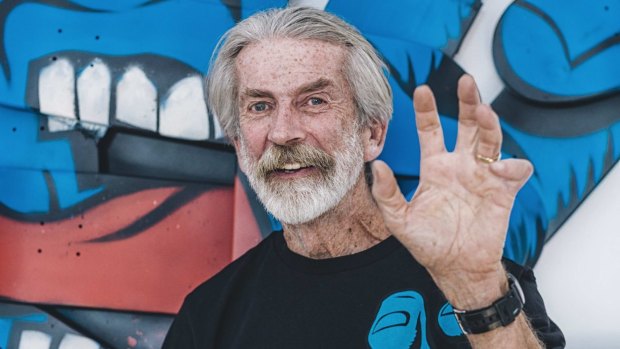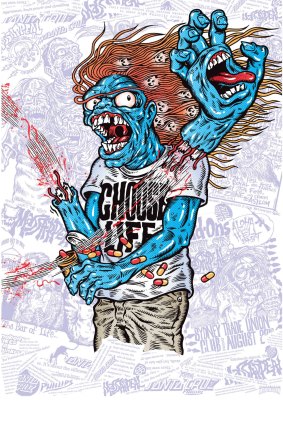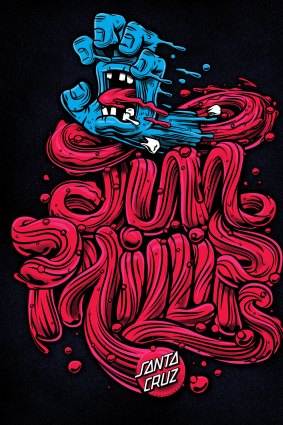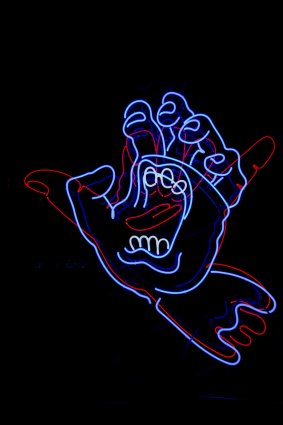This was published 8 years ago
Talk to the (screaming) hand: Show marks 30 years of a skateboarding symbol
A lasting expression of sub-cultural risk-taking still resonates with artists around the world.
By Ray Edgar
Cartoonish defiance characterises streetwear design logos. Mooks' horned lightbulb with its pitchfork element promotes the devilish "idea". Mambo's farting dog shifts mischievous blame. And Californian skateboard label Santa Cruz wears danger on its sleeve. Or it would, if it had one.
The Screaming Hand, for which the label is synonymous, has been shorn off. Call it honesty in branding. It acknowledges skin will be grazed, pain will be suffered, and authority may require a talking-to. If you can be bothered. Talk to the (screaming) hand.

Screaming Hand's creator Jim Phillips. Credit: Nicole Reed
"That's what's great about [skateboarding]," says artist and skater Brad Eastman. "You can seriously hurt yourself: twist ligaments, break arms. But that's why people are drawn to it, because when you're trying to do a trick that high-risk you're not thinking about anything else."
As Screaming Hands' creator, Jim Phillips, explained to T-World journal: "It has become an expression of the inexpressible, because there is no word for AARGH."

Ben Brown's notorious illustration for Sydney speed-metal band Mass Appeal.
That devil-may-care, "gallows" humour resonates with skaters, street artists and illustrators around the world.
Designed in 1985, the screaming hand has been copied, bootlegged and parodied – and not just by Santa Cruz. Now it's the subject of a 30th-anniversary tribute tour to more than 30 cities, including Berlin, Paris and Barcelona, with each city contributing its own local content. Thirty Australian street artists and illustrators will contribute to the Sydney and Melbourne shows.
Unlike the American exhibition of largely graffiti artists, Australian curator Eddie Zammit's call to arms opts for diversity. Luca Ionescu, the typographer behind Baz Luhrmann's Great Gatsby credits, illustrator Ken Taylor, artists George Rose and stencil artist, 23rd key, are among Zammit's selection.
"What's surprised me is that artists who don't skate say they were [also] influenced by skate graphics," says Zammit. "The Screaming Hand is bigger than skateboarding. That's the key story. There's not many symbols that last the test of time."

The Screaming Hand, as interpreted by illustrator Travis Price, who used to copy the image in his youth.
Just as fashion absorbed punk imagery, the subcultural revolt into style grabbed hold of the Screaming Hand. Phillips' bright minimal colours with simple, bold iconography emerged from the crashing together of Californian culture of hot rods, surfing and skateboarding, says illustrator Ben Brown.
In Australia, music was a bigger influence; punk rock its soundtrack. To highlight that connection Brown revisits a notorious illustration he did for Sydney speed-metal band Mass Appeal – a suicidal gun-toting zombie wearing a Wham! 'Choose Life' shirt. The screaming mouth replaces the gun.

George Rose's contribution to the Screaming Hand 30th anniversary exhibition. Credit: Shane Parsons
"There's always been fantastic skateboard graphics and heavier, more deranged images that came before it," says Brown.
"I think it was just something weird enough and funny enough to give it a long life and made it into a mainstream position. There's nothing cliched about it."
The Screaming Hand is bigger than skateboarding. There's not many symbols that last the test of time.
Eddie Zammit
As a kid, illustrator Travis Price used to copy the image: "It taught me how to draw," he says, nostalgically. "While the iconic clenched fist of defiance had a sense of silence to it, the Screaming Hand was a whole new take. Almost like we're not going to sit back in silent protest any more."
They needn't worry. Skating itself has become mainstream. Testimony to that is our changing urban environment. Whether it's the subtle urban choreography landscape architects design to encourage or deter street skating in public plazas, or the 2000-odd skate parks commissioned by local councils across Australia, skateboarding has altered our public spaces.
"Skaters are always looking to be creative with their moves and push the boundaries and that's exactly what design is," says Alaric Hellawell, a landscape architect and skate park designer with Convic, which has designed more than 700 skateparks including award-winning parks in Geelong and St Kilda.
"There's a realisation that it's not for a defined age group any more," says landscape architect Perry Lethlean. "The demographic is massive and very popular. It's not something that was once put down the back paddock catering for a limited few; it's a public space activity that's legitimate, with a large demographic. Once there was that realisation and it's a broad spectrum of families and young and old kids, it's moved it from a problem to a fun, dynamic part of the city."
Screaming Hand 30th anniversary, Ambush Gallery, Level 3 Central Park, 28 Broadway, Chippendale, Sydney, November 5-8; So High Gallery 143a Chapel Street Windsor, Melbourne, November 12-15.